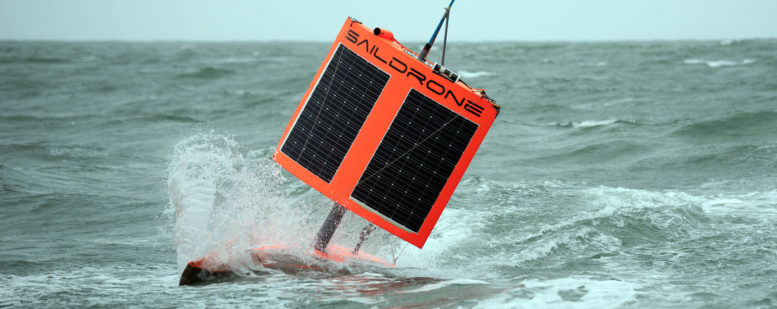A seven-meter (23-foot) long, wind-powered unmanned surface vehicle (USV) called a Saildrone has become the first unmanned system to circumnavigate Antarctica. The vehicle, known as SD 1020, was equipped with a suite of climate-grade sensors, and collected data in previously unchartered waters, enabling new key insights into ocean and climate processes.
The 196-day mission was launched from Southport in Bluff, New Zealand, on 19-January-2019, returning to the same port on August 3 after sailing over 22,000 km (13,670 miles or 11,879 nautical miles) around Antarctica. During the mission, the vehicle survived freezing temperatures, 15-meter (50-foot) waves, 130 km/h (80 mph) winds, and collisions with giant icebergs.
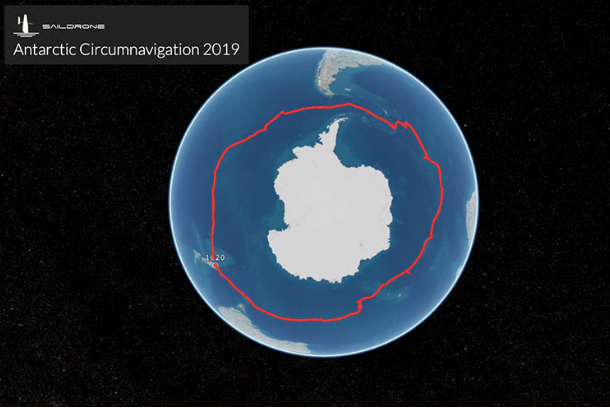
SD 1020 circumnavigated the Southern Ocean, a mission of 22,000 kilometers, in 196 days, the first unmanned system to complete an Antarctic circumnavigation.
Non-profit Li Ka Shing Foundation sponsored this mission. All data is made publicly available at no cost in order to accelerate our understanding of critical processes affecting humanity. The mission is also an educational outreach initiative, aiming to expose future generations to the rapid changes taking place in the Antarctic. Saildrone and the 1851 Trust partnered to develop a series of STEM lesson plans rooted in science, math, technology, and engineering, which are available to teachers free of charge on the Saildrone website at Saildrone.com/antarctica.
Science collaborators on this First Saildrone Antarctic Circumnavigation include experts from: US National Oceanic and Atmospheric Administration (NOAA), the US National Aeronautics and Space Administration (NASA), Australia’s Commonwealth Scientific and Industrial Research Organization (CSIRO), the Palmer Long-Term Ecological Research (LTER), the Scripps Institution of Oceanography, the Southern Ocean Observing System (SOOS), the Japan Agency for Marine-Earth Science and Technology (JAMSTEC), the Korea Polar Research Institute (KOPRI), the Norwegian Polar Institute, the University of Exeter, the University of Gothenburg, the Department of Marine Science, University of Otago, and the New Zealand National Institute of Water and Atmospheric Research (NIWA).
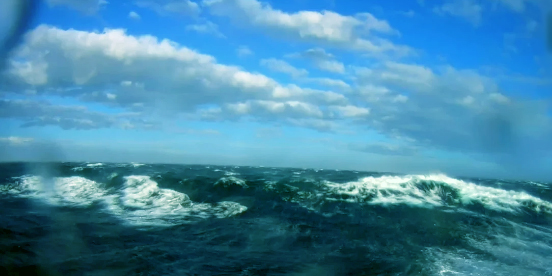
A video was taken from SD 1020’s onboard camera showing the extreme conditions in the Southern Ocean during the 2019 Antarctic Circumnavigation.
The science
The Southern Ocean plays a key role in regulating heat and carbon for our planet. It is so remote and inhospitable that even big ships avoid it in winter. But the nimble and robust Saildrone not only survived the Southern Ocean winter but streamed back vital new data from previously unsampled territory.
“One of our largest ‘blind spots’ in terms of our climate knowledge and its future prediction lies in the Southern Ocean. This is mostly due to the serious lack of observations, in particular in winter, in this remote and harsh environment. This leads to a poor understanding of how these polar oceans function,” said Sebastiaan Swart, co-chair of the Southern Ocean Observing System (SOOS). “These exciting, high-resolution observations from Saildrone during its circumnavigation of the Antarctic provide valuable ground-based datasets for scientists to understand the Southern Ocean better and evaluate the models we use to predict weather and climate.”
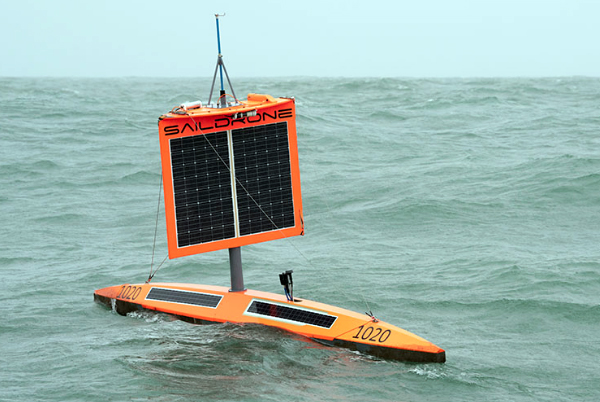
The top of the wing to the bottom of the keel is loaded with science sensors.
Carrying an instrument developed by NOAA to measure carbon fluxes very precisely, the Saildrone provided important new data on the rates of carbon uptake in the Southern Ocean.
“There’s a lot left to be learned about the ocean’s uptake of CO2 emissions, especially in the Southern Ocean. Up until a few years ago, the Southern Ocean was understood to be a large CO2 sink. Yet, that understanding was based primarily on observations made from ships that steer clear of the harshest weather in the Southern Ocean, leaving winter months undersampled,” said explained Dr. Adrienne Sutton, an oceanographer with the NOAA Pacific Marine Environmental Laboratory (PMEL) Carbon Group. The PMEL Carbon Group has been involved in all Saildrone missions related to CO2 to date.
Dr. Sutton said, with the deployment of carbon sensors on profiling float, and the Southern Ocean Carbon and Climate Observations and Modeling (SOCCOM) project, scientists started to get a broader seasonal distribution of observations. They found less of a CO2 sink than previously thought.
The SOCCOM floats measure seawater pH and use empirical relationships to calculate seawater partial pressure of carbon dioxide (pCO2), which introduces some uncertainty relative to a direct measurement. This has generated an active discussion centered on the uncertainty in the calculated pCO2 from the float measurements and whether the weakened CO2 sink, as observed by the floats during 2014–2017, was just natural variability.
Over the course of the mission, the Saildrone rendezvoused with a few of the SOCCOM floats.
“Having another autonomous platform that can survive the Southern Ocean is both a technological feat and an opportunity to get us closer to solving the ocean CO2 sink puzzle! Preliminary results suggest that we also observed CO2 outgassing during winter months in the same region as the floats measured previously. CO2 outgassing from the ocean to the atmosphere occurs when ocean pCO2 levels are higher than atmospheric levels,” explained Dr. Sutton.
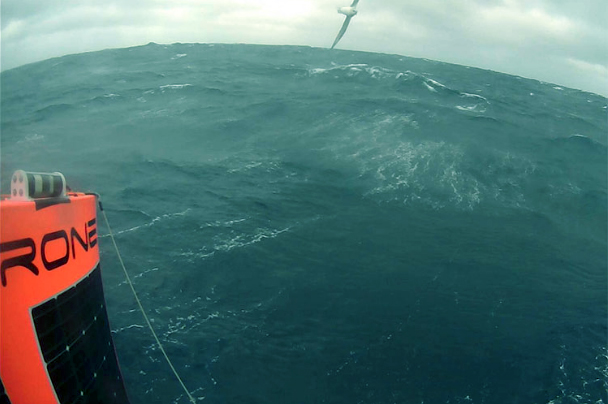
Saildrone onboard cameras also capture images of the local wildlife.
“Our initial findings are that the SOCCOM floats match the Saildrone pCO2 to within their stated uncertainty,” said Nancy Williams, Assistant Professor at the University of South Florida College of Marine Science. “These crossovers provide great opportunities for validation and context between two very different and complementary datasets. Sustaining both of these types of observations will be extremely helpful for improving our understanding of the Southern Ocean’s role in the global carbon budget, and I can’t wait to dive into this new dataset.”
The Saildrone also took reference measurements near moored buoys.
“High quality and reliable data are needed for research use. For the Saildrone sensors, careful calibrations are done before deployment, and other checks are made against similar measurements from a limited number of moorings and profiling floats in the region. The most recent comparison occurred south of Tasmania, Australia, where the Saildrone passed near one of only two Southern Ocean surface moorings equipped with similar sensors,” explained Dr. Bronte Tilbrook, a biogeochemist studying ocean acidification and the global carbon cycle at CSIRO.
“The Saildrone technology is revolutionizing how data can be collected in the Southern Ocean, providing for the first time a way for crucial data to be collected throughout the year and in places that ships rarely visit. Applications include a better understanding of the amount of carbon dioxide taken up by the Southern Ocean and determining the changing environmental conditions and processes driving change,” said Dr. Tilbrook.
All data from this mission has been made publicly available to the global scientific community and its use for science publications is encouraged. Please visit data.Saildrone.com and/or contact us for more information.
A platform for in-situ ocean observations
Saildrone USVs are designed for long-term ocean deployments, up to 12 months, yet burn no fossil fuels, hence have a zero carbon footprint once deployed. They are powered exclusively by the wind for propulsion and solar energy to power the onboard instruments.
Saildrone s carry a suite of science-grade sensors to collect meteorological and oceanographic data critical to understanding the changes taking place in the Antarctic ecosystem. The standard sensor suite includes instruments to measure air and sea temperature, barometric pressure, wind speed and direction, and wave height and period, as well as sky, sea, and horizon cameras. In addition to the ASVCO2, SD 1020’s enhanced sensor package includes an Acoustic Doppler Current Profiler (ADCP) to measure ocean currents.
The secret weapon to take on Southern Ocean winters.
The standard configuration of a Generation 5 Saildrone includes a seven-meter (23-foot) hull, a 2.5-meter (8-foot) keel, and a five-meter (15-foot) tall solid wing. This regular Saildrone wing has an operational wind range up to 60 knots. However, the massive waves of the Southern Ocean were too much for this tall and slender wing. On two previous occasions, in 2015 and 2017, Saildrone s were deployed into the Southern Ocean to attempt the circumnavigation. In each case, after a short period of time, the mission was compromised and the Saildrone s had to sail back for repairs. The team learned a huge amount from these failures and designed a new type of wing specifically for the Southern Ocean. The lower aspect “square rig” is incredibly strong and is designed to deal with the huge forces of being rolled and submerged by 15-meter (50-foot) breaking waves.
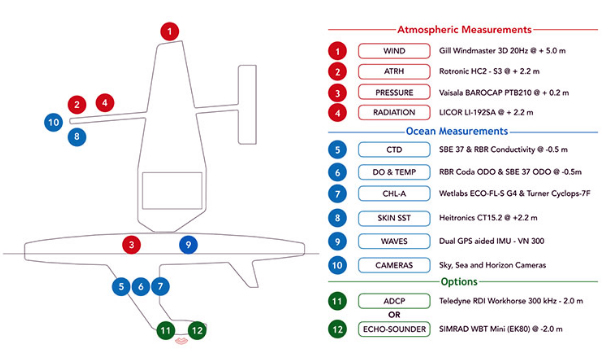
Standard and optional sensors for the Generation 5 Saildrone sensor package.
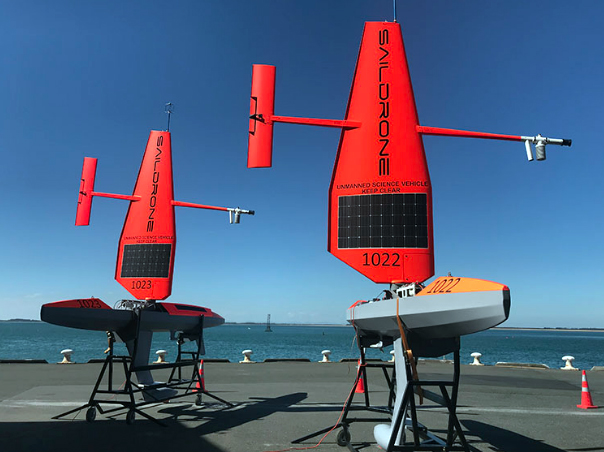
SD 1022 and SD 1023 with the standard Saildrone wing in Point Bluff, NZ.
“While the square rig has less performance range than the regular Saildrone wing and struggles to sail upwind, it does a great job of sailing downwind and can still get you where you need to go in the Southern Ocean,” said Saildrone founder and CEO Richard Jenkins. “You inevitably sacrifice maneuverability for survivability, but we have created something that gets the job done and that the Southern Ocean just can’t destroy!”
SD 1022 and SD 1023 were released with “toughened” regular wings along with SD 1020 in January, but like their predecessors, both suffered storm damage in the first few days, while the square sail plowed on despite stormy conditions. SD 1022 and SD 1023 navigated back to New Zealand for repair and were redeployed in May with square wings similar to SD 1020. These two Saildrone s have recently successfully navigated winter conditions through the Drake Passage and entered the South Atlantic Ocean. Unlike SD 1020, the SD 1022 and SD 1023 are equipped with scientific echo sounders to study fish biomass in addition to the standard atmospheric and oceanographic standard instruments.
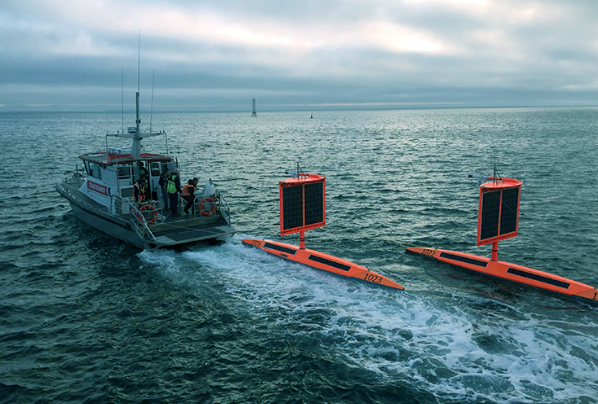
SD 1022 and SD 1023 were redeployed in May 2019 with square wings.
Future plans in the Southern Ocean
Saildrone is building a global fleet of unmanned surface vehicles, targeting planetary coverage.
“In terms of carbon and heat, the Southern Ocean is by far the most important ocean. Globally, the Southern Ocean takes up about half of all carbon and 75% of all heat that enters the ocean. This makes it disproportionately more important to place efforts and resources, such as those occurring by robotic platforms like Saildrone , into obtaining more scientific measurements in this polar region,” said Swart of SOOS.
For Saildrone , this means the Southern Ocean is a key priority to instrument. Saildrone plans to deploy a fleet of vehicles to monitor the Southern Ocean on a persistent basis, a fleet of 10–20 Saildrone s sailing around Antarctica year-round.
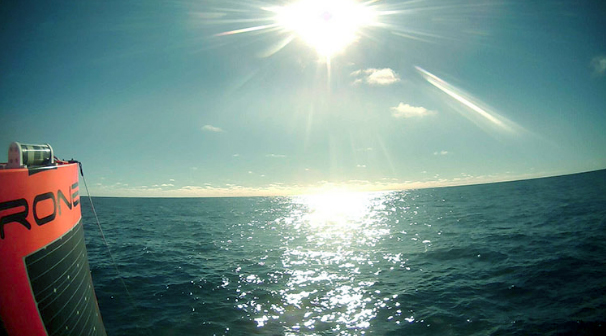
SD 1020 sailing toward the sunrise on a rare calm day in the Southern Ocean.
“A monitoring system for the Southern Ocean is one of our highest priorities,” said Saildrone CEO Jenkins. “Understanding heat and carbon fluxes, fish populations, and ocean acidification in the Southern Ocean are absolutely key to improve the understanding of our climate, and to the sustainability of life on this planet. Only very significantly increased measurement will enable meaningful predictions for the future.”
Saildrone is grateful for the support of its sponsor and scientific collaborators on this historic mission. Saildrone would also like to say a special thank you to the Bluff Coastguard who assisted in towing SD 1020 into the harbor in Bluff, the staff and port of South Port in Bluff, NZ, and Biosecurity New Zealand – Tiakitanga Pūtaiao Aotearoa for inspecting the vehicle on its return.
Resources:
- Saildrone is first to circumnavigate Antarctica, in search for carbon dioxide,” National Oceanic and Atmospheric Administration (NOAA), accessed 5-August-2019
- Ashlee Vance, “Saildrone ’s Journey Around Antarctica Uncovers New Climate Clues,” Bloomberg Businessweek, 5-August-2019.








